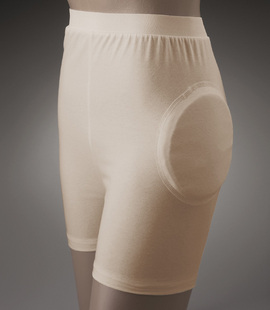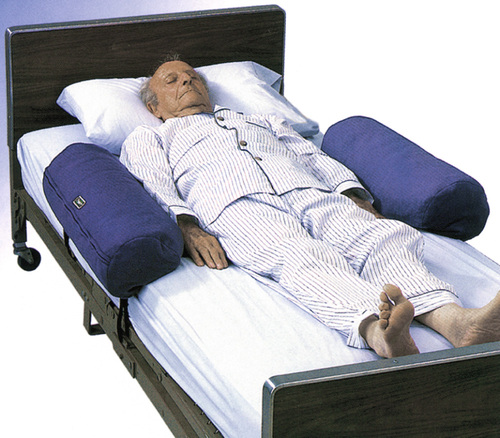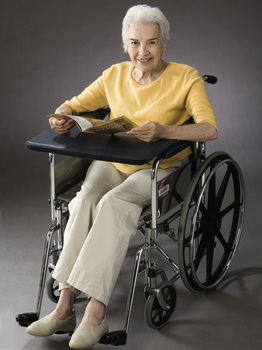Restraint Alternatives and Safe Restraint Use
Objectives
• Define the key terms and key abbreviations in this chapter.
• Describe the purpose of restraints.
• Identify the risk factors related to restraint use.
• Identify restraint alternatives.
• Explain the legal aspects of restraint use.
• Explain how to use restraints safely.
• Perform the procedure described in this chapter.
• Explain how to promote PRIDE in the person, the family, and yourself.
Key Terms
Key Abbreviations
| CMS | Centers for Medicare & Medicaid Services |
| FDA | Food and Drug Administration |
| OBRA | Omnibus Budget Reconciliation Act of 1987 |
| ROM | Range-of-motion |
| TJC | The Joint Commission |
Chapters 13 and 14 have many safety measures. However, some persons need extra protection. They may present dangers to themselves or others (including staff).
The Centers for Medicare & Medicaid Services (CMS) has rules for using restraints. Like the Omnibus Budget Reconciliation Act of 1987 (OBRA), CMS rules protect the person’s rights and safety. This includes the right to be free from restraint. Restraints may be used only to treat a medical symptom or for the immediate physical safety of the person or others. Restraints may be used only when less restrictive measures fail to protect the person or others. They must be discontinued as soon as possible.
The CMS uses these terms.
• Physical restraint—any manual method or physical or mechanical device, material, or equipment attached to or near the person’s body that he or she cannot remove easily and that restricts freedom of movement or normal access to one’s body.
• Chemical restraint—any drug used for discipline or convenience and not required to treat medical symptoms. The drug or dosage is not a standard treatment for the person’s condition.
• Freedom of movement—any change in place or position of the body or any part of the body that the person is able to control.
• Convenience—any action taken to control or manage a person’s behavior that requires less effort by the staff; the action is not in the person’s best interest.
• Discipline—any action taken by the agency to punish or penalize a patient or resident.
• Remove easily—the manual method, device, material, or equipment used to restrain the person that can be removed intentionally by the person in the same manner it was applied by the staff. For example, the person can put bed rails down, untie a knot, or unclasp a buckle.
History of Restraint Use
Restraints were once used to prevent falls. Research shows that restraints cause falls. Falls occur when persons try to get free of the restraints. Injuries are more serious from falls in restrained persons than in those not restrained.
Restraints also were used to prevent wandering or interfering with treatment. They were often used for confusion, poor judgment, or behavior problems. Older persons were restrained more often than younger persons were. Restraints were viewed as necessary devices to protect a person. However, they can cause serious harm, even death. See “Risks From Restraint Use” on p. 203.
Besides the CMS, the Food and Drug Administration (FDA), state agencies, and The Joint Commission (TJC—an accrediting agency) have guidelines for restraint use. They do not forbid restraint use. They require considering or trying all other appropriate alternatives first.
Every agency has policies and procedures for restraints. They include identifying persons at risk for harm, harmful behaviors, restraint alternatives, and proper restraint use. Staff training is required.
Restraint Alternatives
Often there are causes and reasons for harmful behaviors. Knowing and treating the cause can prevent restraint use. This is very important for persons with speech or cognitive problems. The nurse tries to find out what the behavior means.
• Is the person in pain, ill, or injured?
• Is the person short of breath? Are cells getting enough oxygen (Chapter 39)?
• Is the person afraid in a new setting?
• Does the person need to use the bathroom?
• Is clothing or a wound dressing (Chapter 36) tight or causing other discomfort?
• Is the person’s position uncomfortable?
• Are body fluids, secretions, or excretions causing skin irritation?
• Is the person too hot or too cold? Hungry or thirsty?
• What are the person’s life-long habits?
• Does the person have problems communicating?
• Is the person seeing, hearing, or feeling things that are not real (Chapters 48 and 49)?
• Is the person confused or disoriented (Chapter 49)?
Restraint alternatives for the person are identified in the care plan (Box 15-1). The care plan is changed as needed. Restraint alternatives may not protect the person. The doctor may need to order restraints.
Safe Restraint Use
Restraints can cause serious injury and even death. CMS, OBRA, FDA, and TJC rules and guidelines are followed. So are state laws. They are part of the agency’s policies and procedures for restraint use.
Restraints are not used to discipline a person. They are not used for staff convenience. Restraints are used only when necessary to treat medical symptoms. A medical symptom is an indication or characteristic of a physical or psychological condition. Symptoms may relate to physical, emotional, or behavioral problems. Sometimes restraints are needed to protect the person or others. That is, a person may have violent or aggressive behaviors that are harmful to self or others or that are threatening to others.
See Focus on Surveys: Safe Restraint Use.
Physical and Chemical Restraints
According to the CMS, a physical restraint includes these points.
• May be any manual method, physical or mechanical device, material, or equipment.
• Is attached to or next to the person’s body.
• Cannot be removed easily by the person.
• Restricts freedom of movement or normal access to one’s body.
Physical restraints are applied to the chest, waist, elbows, wrists, hands, or ankles. They confine the person to a bed or chair. Or they prevent movement of a body part. Some furniture or barriers also prevent freedom of movement.
• A device used with a chair that the person cannot remove easily. The device prevents the person from rising. Trays, tables, bars, and belts are examples (Fig. 15-3).
• Any chair that prevents the person from rising.
• Any bed or chair placed so close to the wall that the person cannot get out of the bed or chair.
• Bed rails (Chapter 14) that prevent the person from getting out of bed. For example, 4 half-length bed rails are raised. They are restraints if the person cannot lower them.
Drugs or drug dosages are chemical restraints if they:
Drugs cannot be used for discipline or staff convenience. They cannot be used if they affect physical or mental function.
Sometimes drugs can help persons who are confused or disoriented. They may be anxious, agitated, or aggressive. The doctor may order drugs to control these behaviors. The drugs should not make the person sleepy and unable to function at his or her highest level.
Enablers.
An enabler is a device that limits freedom of movement but is used to promote independence, comfort, or safety. Some devices can be restraints or enablers. When the person can easily remove the device and it helps the person function, it is an enabler. For example:
• A chair or wheelchair with a lap-top tray for meals, writing, and so on (see Fig. 15-3). The chair is an enabler. If used to limit freedom of movement, the chair is a restraint.
Risks From Restraint Use
Box 15-2 lists the risks from restraints. Injuries can occur as the person tries to get free of the restraint. Injuries also occur from using the wrong restraint, applying it wrong, or keeping it on too long. Cuts, bruises, and fractures are common. The most serious risk is death from strangulation.
Restraints are medical devices. The Safe Medical Devices Act applies if a restraint causes illness, injury, or death. Also, CMS requires the reporting of any death that occurs:
Laws, Rules, and Guidelines
Laws (federal and state) and rules (CMS, FDA) for restraint use are followed. So are accrediting agency (TJC) guidelines. Remember:
• Restraints are used only after other measures fail to protect the person (see Box 15-1). Some people can harm themselves or others. The care plan must include measures to protect the person and prevent harm to others. Many fall prevention measures are restraint alternatives (Chapter 14).
• Unnecessary restraint is false imprisonment (Chapter 5). You must clearly understand the reason for the restraint and its risks. If not, politely ask about its use. If you apply an unneeded restraint, you could face false imprisonment charges.
Safety Guidelines
The restrained person must be kept safe. Follow the safety measures in Box 15-3. Also remember these key points.
• Remove or release the restraint, re-position the person, and meet basic needs at least every 2 hours. Or do so as often as noted in the care plan.
• Remove or release the restraint for at least 10 minutes.
• Provide for food, fluid, comfort, safety, hygiene, and elimination needs. Also give skin care.
• Perform ROM exercises or help the person walk (Chapter 30). Follow the care plan.
Stay updated, free articles. Join our Telegram channel

Full access? Get Clinical Tree





